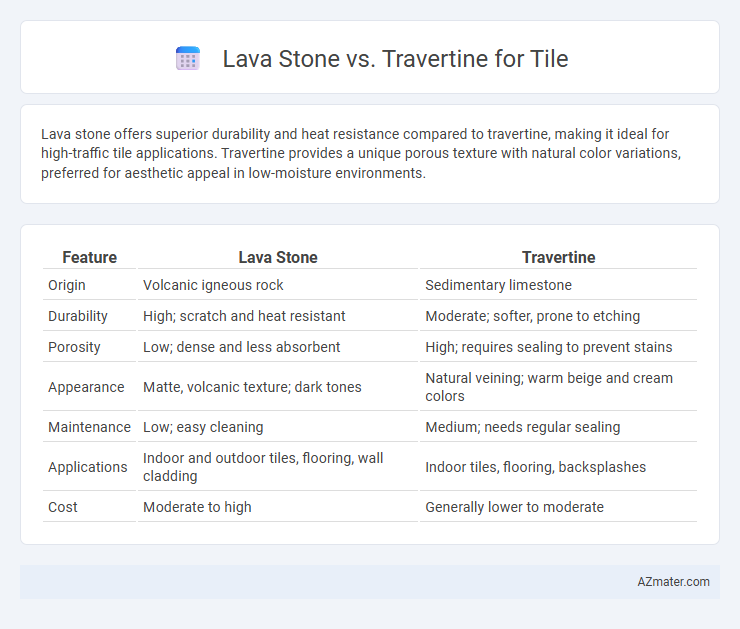Lava stone offers superior durability and heat resistance compared to travertine, making it ideal for high-traffic tile applications. Travertine provides a unique porous texture with natural color variations, preferred for aesthetic appeal in low-moisture environments.
Table of Comparison
| Feature | Lava Stone | Travertine |
|---|---|---|
| Origin | Volcanic igneous rock | Sedimentary limestone |
| Durability | High; scratch and heat resistant | Moderate; softer, prone to etching |
| Porosity | Low; dense and less absorbent | High; requires sealing to prevent stains |
| Appearance | Matte, volcanic texture; dark tones | Natural veining; warm beige and cream colors |
| Maintenance | Low; easy cleaning | Medium; needs regular sealing |
| Applications | Indoor and outdoor tiles, flooring, wall cladding | Indoor tiles, flooring, backsplashes |
| Cost | Moderate to high | Generally lower to moderate |
Introduction to Lava Stone and Travertine Tiles
Lava stone tiles, formed from cooled volcanic lava, are known for their durability, heat resistance, and unique porous texture, making them ideal for both indoor and outdoor surfaces. Travertine tiles, a type of natural limestone formed in mineral springs, feature a distinct, earthy appearance with natural pits and troughs, popular in luxury flooring and wall applications. Both materials offer different aesthetic and functional benefits, with lava stone emphasizing rugged resilience and travertine highlighting classic elegance.
Formation and Geological Origins
Lava stone tiles originate from rapidly cooled molten lava, primarily basaltic in composition, formed during volcanic eruptions, resulting in a dense, durable material with natural vesicular textures. Travertine tiles derive from calcium carbonate deposits in mineral-rich hot springs and limestone caves, characterized by its porous structure and concentric layered appearance. The geological origin of lava stone emphasizes igneous volcanic activity, while travertine is sedimentary, formed through the precipitation of groundwater minerals.
Appearance and Color Variations
Lava stone tiles feature a porous, textured surface with deep, rich hues ranging from dark charcoal to rusty reds, adding a rustic and volcanic aesthetic to spaces. Travertine tiles exhibit a smoother, more polished finish with natural, warm earth tones like beige, cream, and honey, often showcasing unique swirling patterns and fossilized inclusions. Both materials offer distinctive color variations that enhance design flexibility, but lava stone provides a rugged, matte appearance while travertine delivers a classic, elegant look.
Durability and Strength Comparison
Lava stone exhibits exceptional durability and high resistance to scratches and heat, making it ideal for heavy-traffic areas and outdoor installations. Travertine, while aesthetically appealing with its natural veining, is more porous and softer, requiring regular sealing to maintain its strength and prevent wear. In terms of longevity, lava stone generally outperforms travertine due to its dense composition and robust structural integrity.
Porosity and Water Resistance
Lava stone exhibits low porosity and high water resistance, making it an ideal choice for areas prone to moisture and spills. Travertine, with its naturally porous surface, requires sealing to enhance its water resistance and prevent staining. The inherent density of lava stone provides superior durability and longevity compared to the more absorbent travertine tile.
Maintenance Requirements
Lava stone tiles require minimal maintenance due to their natural porosity and durability, often needing only regular sealing and gentle cleaning to prevent stains and moisture absorption. Travertine tiles demand more intensive upkeep, including frequent sealing to protect against water damage and staining, as the stone's open pores make it susceptible to dirt and wear. Both materials benefit from pH-neutral cleaners, but Lava stone offers a more resilient and low-maintenance option for high-traffic areas.
Application Areas: Indoor vs. Outdoor
Lava stone excels in outdoor applications due to its durability, resistance to weather, and slip-resistant surface, making it ideal for patios, walkways, and pool surrounds. Travertine is better suited for indoor use where its porous texture requires sealing to prevent staining, commonly featured in bathrooms, kitchens, and indoor flooring. Both stones offer unique aesthetic and functional benefits, but selecting between lava stone and travertine depends on exposure to elements and maintenance requirements.
Cost Differences and Budget Considerations
Lava stone tiles generally cost between $15 and $30 per square foot, making them a more affordable option compared to travertine, which ranges from $25 to $50 per square foot. Budget considerations include the lower maintenance requirements and durability of lava stone, which can reduce long-term expenses. Travertine's higher price reflects its luxurious appearance and natural veining, appealing to projects with a larger budget for premium aesthetics.
Environmental Impact and Sustainability
Lava stone tiles are highly sustainable due to their natural volcanic origin and minimal processing requirements, resulting in a lower carbon footprint compared to travertine. Travertine, a sedimentary limestone, involves more intensive quarrying and processing, leading to greater environmental disruption and energy consumption. Lava stone's durability and natural thermal properties also contribute to its eco-friendly profile, making it a preferred choice for sustainable tile applications.
Final Verdict: Choosing the Best Tile for Your Project
Lava stone offers exceptional durability and heat resistance, making it ideal for high-traffic areas and outdoor installations, while travertine provides a classic, elegant look with its unique porous texture suited for indoor spaces like bathrooms and living rooms. Consider the project's environment and maintenance preferences; lava stone requires minimal upkeep and is highly stain-resistant, whereas travertine demands regular sealing to prevent damage. For a balance of toughness and aesthetic appeal, select lava stone for robust, modern designs and travertine for timeless, sophisticated interiors.

Infographic: Lava stone vs Travertine for Tile
 azmater.com
azmater.com